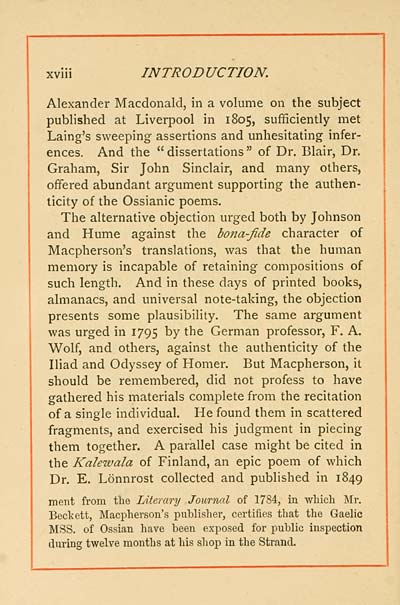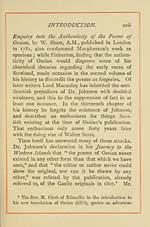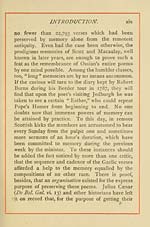Ossian Collection > Poems of Ossian
(20)
Download files
Complete book:
Individual page:
Thumbnail gallery: Grid view | List view

xviii INTRODUCTION.
Alexander Macdonald, in a volume on the subject
published at Liverpool in 1805, sufficiently met
Laing's sweeping assertions and unhesitating infer-
ences. And the " dissertations " of Dr. Blair, Dr.
Graham, Sir John Sinclair, and many others,
offered abundant argument supporting the authen-
ticity of the Ossianic poems.
The alternative objection urged both by Johnson
and Hume against the bona-fide character of
Macpherson's translations, was that the human
memory is incapable of retaining compositions of
such length. And in these days of printed books,
almanacs, and universal note-taking, the objection
presents some plausibility. The same argument
was urged in 1795 by the German professor, F. A.
Wolf, and others, against the authenticity of the
Iliad and Odyssey of Homer. But Macpherson, it
should be remembered, did not profess to have
gathered his materials complete from the recitation
of a single individual. He found them in scattered
fragments, and exercised his judgment in piecing
them together. A parallel case might be cited in
the Kalewala of Finland, an epic poem of which
Dr. E. Lonnrost collected and published in 1849
merit from the Literary Journal of 1784, in which Mr.
Beckett, Macpherson's publisher, certifies that the Gaelic
MSS. of Ossian have been exposed for public inspection
during twelve months at his shop in the Strand.
Alexander Macdonald, in a volume on the subject
published at Liverpool in 1805, sufficiently met
Laing's sweeping assertions and unhesitating infer-
ences. And the " dissertations " of Dr. Blair, Dr.
Graham, Sir John Sinclair, and many others,
offered abundant argument supporting the authen-
ticity of the Ossianic poems.
The alternative objection urged both by Johnson
and Hume against the bona-fide character of
Macpherson's translations, was that the human
memory is incapable of retaining compositions of
such length. And in these days of printed books,
almanacs, and universal note-taking, the objection
presents some plausibility. The same argument
was urged in 1795 by the German professor, F. A.
Wolf, and others, against the authenticity of the
Iliad and Odyssey of Homer. But Macpherson, it
should be remembered, did not profess to have
gathered his materials complete from the recitation
of a single individual. He found them in scattered
fragments, and exercised his judgment in piecing
them together. A parallel case might be cited in
the Kalewala of Finland, an epic poem of which
Dr. E. Lonnrost collected and published in 1849
merit from the Literary Journal of 1784, in which Mr.
Beckett, Macpherson's publisher, certifies that the Gaelic
MSS. of Ossian have been exposed for public inspection
during twelve months at his shop in the Strand.
Set display mode to: Large image | Transcription
Images and transcriptions on this page, including medium image downloads, may be used under the Creative Commons Attribution 4.0 International Licence unless otherwise stated. ![]()
| Early Gaelic Book Collections > Ossian Collection > Poems of Ossian > (20) |
|---|
| Permanent URL | https://digital.nls.uk/77843668 |
|---|
| Description | Selected books from the Ossian Collection of 327 volumes, originally assembled by J. Norman Methven of Perth. Different editions and translations of James MacPherson's epic poem 'Ossian', some with a map of the 'Kingdom of Connor'. Also secondary material relating to Ossianic poetry and the Ossian controversy. |
|---|
| Description | Selected items from five 'Special and Named Printed Collections'. Includes books in Gaelic and other Celtic languages, works about the Gaels, their languages, literature, culture and history. |
|---|

